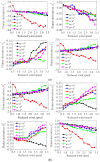Wind Tunnel Measurements for Flutter of a Long-Afterbody Bridge Deck
- PMID: 28208773
- PMCID: PMC5336026
- DOI: 10.3390/s17020335
Wind Tunnel Measurements for Flutter of a Long-Afterbody Bridge Deck
Abstract
Bridges are an important component of transportation. Flutter is a self-excited, large amplitude vibration, which may lead to collapse of bridges. It must be understood and avoided. This paper takes the Jianghai Channel Bridge, which is a significant part of the Hong Kong-Zhuhai-Macao Bridge, as an example to investigate the flutter of the bridge deck. Firstly, aerodynamic force models for flutter of bridges were introduced. Then, wind tunnel tests of the bridge deck during the construction and the operation stages, under different wind attack angles and wind velocities, were carried out using a high frequency base balance (HFBB) system and laser displacement sensors. From the tests, the static aerodynamic forces and flutter derivatives of the bridge deck were observed. Correspondingly, the critical flutter wind speeds of the bridge deck were determined based on the derivatives, and they are compared with the directly measured flutter speeds. Results show that the observed derivatives are reasonable and applicable. Furthermore, the critical wind speeds in the operation stage is smaller than those in the construction stage. Besides, the flutter instabilities of the bridge in the construction and the operation stages are good. This study helps guarantee the design and the construction of the Jianghai Channel Bridge, and advances the understanding of flutter of long afterbody bridge decks.
Keywords: aerodynamic force; critical flutter wind speed; flutter derivatives; long-afterbody bridge deck.
Conflict of interest statement
The authors declare no conflict of interest.
Figures












References
-
- Gu M., Zhang R., Xiang H. Identification of flutter derivatives of bridge decks. J. Wind Eng. Ind. Aerodyn. 2000;84:151–162. doi: 10.1016/S0167-6105(99)00051-3. - DOI
-
- Ge Y., Xiang H., Tanaka H. Application of a reliability analysis model to bridge flutter under extreme winds. J. Wind Eng. Ind. Aerodyn. 2000;86:155–167. doi: 10.1016/S0167-6105(00)00008-8. - DOI
-
- Gu M., Chang C., Wu W., Xiang H. Increase of critical flutter wind speed of long-span bridges using tuned mass dampers. J. Wind Eng. Ind. Aerodyn. 1998;73:111–123. doi: 10.1016/S0167-6105(97)00282-1. - DOI
LinkOut - more resources
Full Text Sources
Other Literature Sources

